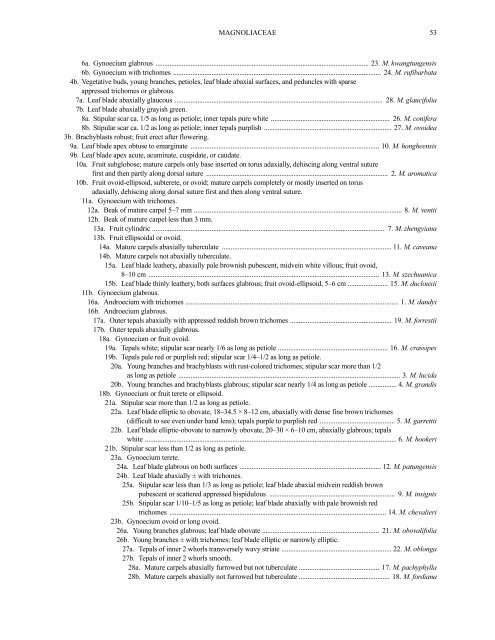Magnoliaceae (PDF)
Magnoliaceae (PDF)
Magnoliaceae (PDF)
Create successful ePaper yourself
Turn your PDF publications into a flip-book with our unique Google optimized e-Paper software.
MAGNOLIACEAE<br />
6a. Gynoecium glabrous .......................................................................................................................... 23. M. kwangtungensis<br />
6b. Gynoecium with trichomes ....................................................................................................................... 24. M. rufibarbata<br />
4b. Vegetative buds, young branches, petioles, leaf blade abaxial surfaces, and peduncles with sparse<br />
appressed trichomes or glabrous.<br />
7a. Leaf blade abaxially glaucous ....................................................................................................................... 28. M. glaucifolia<br />
7b. Leaf blade abaxially grayish green.<br />
8a. Stipular scar ca. 1/5 as long as petiole; inner tepals pure white .................................................................... 26. M. conifera<br />
8b. Stipular scar ca. 1/2 as long as petiole; inner tepals purplish ......................................................................... 27. M. ovoidea<br />
3b. Brachyblasts robust; fruit erect after flowering.<br />
9a. Leaf blade apex obtuse to emarginate ............................................................................................................ 10. M. hongheensis<br />
9b. Leaf blade apex acute, acuminate, cuspidate, or caudate.<br />
10a. Fruit subglobose; mature carpels only base inserted on torus adaxially, dehiscing along ventral suture<br />
first and then partly along dorsal suture ........................................................................................................ 2. M. aromatica<br />
10b. Fruit ovoid-ellipsoid, subterete, or ovoid; mature carpels completely or mostly inserted on torus<br />
adaxially, dehiscing along dorsal suture first and then along ventral suture.<br />
11a. Gynoecium with trichomes.<br />
12a. Beak of mature carpel 5–7 mm ....................................................................................................................... 8. M. ventii<br />
12b. Beak of mature carpel less than 3 mm.<br />
13a. Fruit cylindric ..................................................................................................................................... 7. M. zhengyiana<br />
13b. Fruit ellipsoidal or ovoid.<br />
14a. Mature carpels abaxially tuberculate ................................................................................................. 11. M. caveana<br />
14b. Mature carpels not abaxially tuberculate.<br />
15a. Leaf blade leathery, abaxially pale brownish pubescent, midvein white villous; fruit ovoid,<br />
8–10 cm .................................................................................................................................... 13. M. szechuanica<br />
15b. Leaf blade thinly leathery, both surfaces glabrous; fruit ovoid-ellipsoid, 5–6 cm ....................... 15. M. duclouxii<br />
11b. Gynoecium glabrous.<br />
16a. Androecium with trichomes .......................................................................................................................... 1. M. dandyi<br />
16b. Androecium glabrous.<br />
17a. Outer tepals abaxially with appressed reddish brown trichomes .......................................................... 19. M. forrestii<br />
17b. Outer tepals abaxially glabrous.<br />
18a. Gynoecium or fruit ovoid.<br />
19a. Tepals white; stipular scar nearly 1/6 as long as petiole ............................................................... 16. M. crassipes<br />
19b. Tepals pale red or purplish red; stipular scar 1/4–1/2 as long as petiole.<br />
20a. Young branches and brachyblasts with rust-colored trichomes; stipular scar more than 1/2<br />
as long as petiole ............................................................................................................................... 3. M. lucida<br />
20b. Young branches and brachyblasts glabrous; stipular scar nearly 1/4 as long as petiole ................ 4. M. grandis<br />
18b. Gynoecium or fruit terete or ellipsoid.<br />
21a. Stipular scar more than 1/2 as long as petiole.<br />
22a. Leaf blade elliptic to obovate, 18–34.5 × 8–12 cm, abaxially with dense fine brown trichomes<br />
(difficult to see even under hand lens); tepals purple to purplish red ........................................... 5. M. garrettii<br />
22b. Leaf blade elliptic-obovate to narrowly obovate, 20–30 × 6–10 cm, abaxially glabrous; tepals<br />
white ................................................................................................................................................ 6. M. hookeri<br />
21b. Stipular scar less than 1/2 as long as petiole.<br />
23a. Gynoecium terete.<br />
24a. Leaf blade glabrous on both surfaces ................................................................................. 12. M. patungensis<br />
24b. Leaf blade abaxially ± with trichomes.<br />
25a. Stipular scar less than 1/3 as long as petiole; leaf blade abaxial midvein reddish brown<br />
pubescent or scattered appressed hispidulous ........................................................................ 9. M. insignis<br />
25b. Stipular scar 1/10–1/5 as long as petiole; leaf blade abaxially with pale brownish red<br />
trichomes ............................................................................................................................ 14. M. chevalieri<br />
23b. Gynoecium ovoid or long ovoid.<br />
26a. Young branches glabrous; leaf blade obovate ................................................................... 21. M. obovalifolia<br />
26b. Young branches ± with trichomes; leaf blade elliptic or narrowly elliptic.<br />
27a. Tepals of inner 2 whorls transversely wavy striate ............................................................... 22. M. oblonga<br />
27b. Tepals of inner 2 whorls smooth.<br />
28a. Mature carpels abaxially furrowed but not tuberculate .............................................. 17. M. pachyphylla<br />
28b. Mature carpels abaxially not furrowed but tuberculate .................................................... 18. M. fordiana<br />
53

















